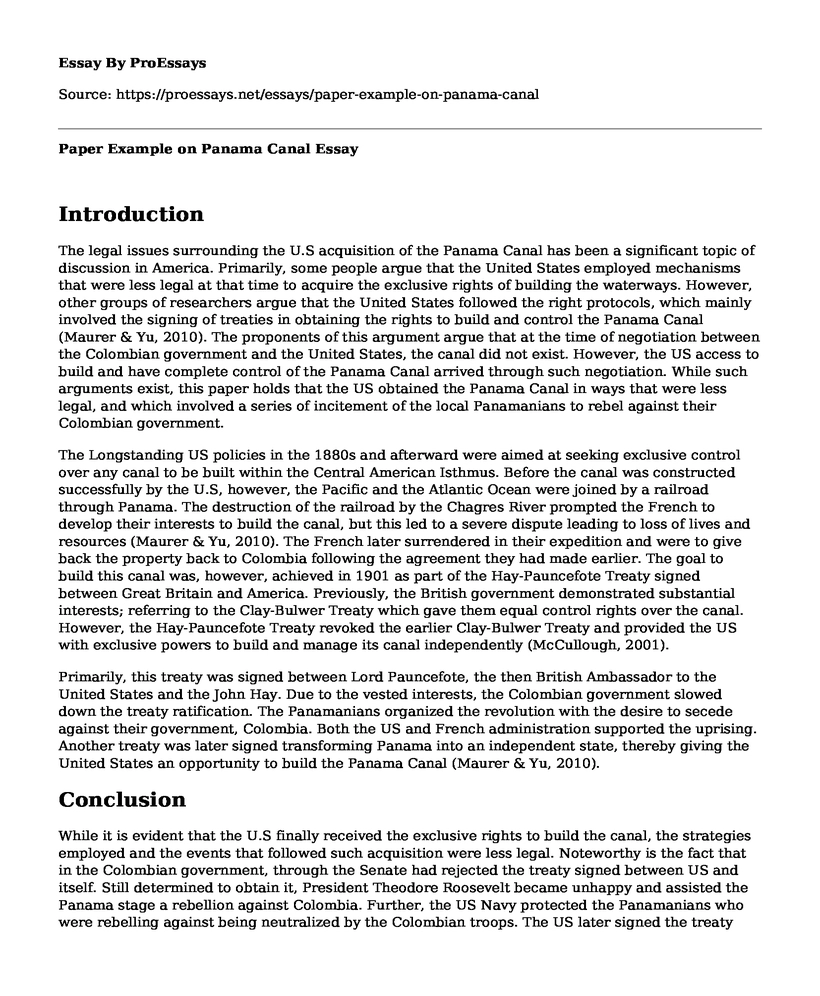Introduction
The legal issues surrounding the U.S acquisition of the Panama Canal has been a significant topic of discussion in America. Primarily, some people argue that the United States employed mechanisms that were less legal at that time to acquire the exclusive rights of building the waterways. However, other groups of researchers argue that the United States followed the right protocols, which mainly involved the signing of treaties in obtaining the rights to build and control the Panama Canal (Maurer & Yu, 2010). The proponents of this argument argue that at the time of negotiation between the Colombian government and the United States, the canal did not exist. However, the US access to build and have complete control of the Panama Canal arrived through such negotiation. While such arguments exist, this paper holds that the US obtained the Panama Canal in ways that were less legal, and which involved a series of incitement of the local Panamanians to rebel against their Colombian government.
The Longstanding US policies in the 1880s and afterward were aimed at seeking exclusive control over any canal to be built within the Central American Isthmus. Before the canal was constructed successfully by the U.S, however, the Pacific and the Atlantic Ocean were joined by a railroad through Panama. The destruction of the railroad by the Chagres River prompted the French to develop their interests to build the canal, but this led to a severe dispute leading to loss of lives and resources (Maurer & Yu, 2010). The French later surrendered in their expedition and were to give back the property back to Colombia following the agreement they had made earlier. The goal to build this canal was, however, achieved in 1901 as part of the Hay-Pauncefote Treaty signed between Great Britain and America. Previously, the British government demonstrated substantial interests; referring to the Clay-Bulwer Treaty which gave them equal control rights over the canal. However, the Hay-Pauncefote Treaty revoked the earlier Clay-Bulwer Treaty and provided the US with exclusive powers to build and manage its canal independently (McCullough, 2001).
Primarily, this treaty was signed between Lord Pauncefote, the then British Ambassador to the United States and the John Hay. Due to the vested interests, the Colombian government slowed down the treaty ratification. The Panamanians organized the revolution with the desire to secede against their government, Colombia. Both the US and French administration supported the uprising. Another treaty was later signed transforming Panama into an independent state, thereby giving the United States an opportunity to build the Panama Canal (Maurer & Yu, 2010).
Conclusion
While it is evident that the U.S finally received the exclusive rights to build the canal, the strategies employed and the events that followed such acquisition were less legal. Noteworthy is the fact that in the Colombian government, through the Senate had rejected the treaty signed between US and itself. Still determined to obtain it, President Theodore Roosevelt became unhappy and assisted the Panama stage a rebellion against Colombia. Further, the US Navy protected the Panamanians who were rebelling against being neutralized by the Colombian troops. The US later signed the treaty with the Panamanian prime minister, who was a Frenchman and a part of the company awarded the tender to construct the canal. It became an essential tool for the military, commercial and strategic importance for US activities. In 1999, the control of the canal was passed to the government of Panama.
References
Maurer, N., & Yu, C. (2010). The big ditch: How America took, built, ran, and ultimately gave away the Panama Canal. Princeton University Press.Bottom of Form
McCullough, D. (2001). The path between the seas: the creation of the Panama Canal, 1870-1914. Simon and Schuster.
Cite this page
Paper Example on Panama Canal. (2022, Jul 04). Retrieved from https://proessays.net/essays/paper-example-on-panama-canal
If you are the original author of this essay and no longer wish to have it published on the ProEssays website, please click below to request its removal:
- Case Analysis Essay: United States vs. Bailey
- Paper Example on Modern American Art
- Essay Example on Creating Lasting Change Across Borders: My Service Project
- Report Sample on MANNA: Targeted Health Intervention for Hypertension
- Movie Review Example on Apocalypto: Mayan Kingdom in Crisis (1502s)
- Essay Sample on Mexican American Women's Rebellion Against Social Conventions During WWII
- Essay Sample on Childish Gambino's This is America: A Commentary on American Society







